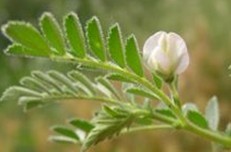The chickpea (Cicer arietinum) is a legume of the family Fabaceae, subfamily Faboideae. Its seeds are high in protein. It is one of the earliest cultivated legumes: 7,500-year-old remains have been found in the Middle East.
The plant grows to between 20–50 cm (8–20 inches) high and has small feathery leaves on either side of the stem. Chickpeas are a type of pulse, with one seedpod containing two or three peas. It has white flowers with blue, violet or pink veins. Chickpeas need a subtropical or tropical climate with more than 400 millimetres (16 in) of annual rain.
Chickpeas are grown in the Mediterranean, western Asia, the Indian subcontinent and Australia. Mature chickpeas can be cooked and eaten cold in salads, cooked in stews, ground into a flour called gram flour (also known as chickpea flour and besan and used frequently in Indian cuisine), ground and shaped in balls and fried as falafel, stirred into a batter and baked to make farinata.
| Catalog | Product Name | CAS Number | Manual |
|---|---|---|---|
| CFN99734 | Biochanin A | 491-80-5 | |
| CFN99962 | Formononetin | 485-72-3 | |
| CFN99136 | Ononin | 486-62-4 | |
| CFN99140 | Calycosin | 20575-57-9 | |
| CFN99141 | Calycosin-7-O-beta-D-glucoside | 20633-67-4 | |
| CFN98681 | Genistein | 446-72-0 | |
| CFN93168 | Linoleic acid | 60-33-3 | |
| CFN99916 | Beta-Sitosterol | 83-46-5 | |
| CFN97577 | 4-Hydroxybenzoic acid | 99-96-7 | |
| CFN98992 | Adenosine | 58-61-7 | |
| CFN98970 | Sucrose | 57-50-1 | n/a |
A unique collection of 25 natural compounds from Platycladus orientalis
A unique collection of 31 natural compounds from Garcinia multiflora Champ.
A unique collection of 28 natural compounds from Taxus cuspidata Sieb. Et Zucc.
A unique collection of 23 natural compounds from Psoralea bituminosa L.
A unique collection of 24 natural compounds from Zingiber officinale Roscoe





